Oral Tradition
In the third year of my filmmaking degree I realised that my screenwriting lecturer was a bullshitter. What’s worse is that I also realised I kinda admired it; it didn’t really matter if the stories he told were true, only that remembering them makes me howl.
One week, he needed a last-minute sound recordist for his PhD project. Having zero interest or experience in sound recording, but having quite a lot of interest in spending the day with this man, his 15-years-junior fiancee, and their baby, I decided to volunteer.
On the day I wore my brand new white trainers. Experimental musician-slash-actress Keeley Forsyth was there, too. We spent the day driving around Halifax and walking through fields, and alleys, and ginnels, and mud.
At midday, on a staircase running up the side of a pub and towards an overpass above it, he bent over to tie his shoes. His glasses fell off his face and into a tidy pile of literal shit. He picked them up, gave them a sniff, assuredly proclaimed “this is human shit”, and threw them aside.
During the drive back, he explained to me the one time someone had cursed him. Famed actor Donald Sutherland, specifically, had cursed him because he refused to foot the bill for a £150 bottle of wine. Donald ordered the waiter to open the bottle and pour a glass; he dipped his thumb in the wine and leant over to draw a cross on my lecturer’s forehead. Whether the curse has come to pass I don’t yet know.
My brand new white trainers were fucking ruined and, in retrospect, I think I got cursed by proxy.
But that was one of the lessons of film school I’ll never forget: stories are fun. I love to embellish and pretend and reframe and bullshit, sometimes. All you have to do is call it oral tradition and nobody bats an eyelid.
The Wachowskis
A few weeks ago I tweeted this:
want a game that's gonna emotionally ruin me - obvious runner up is disco but I don't have the time to commit to it right now, so I'm thinking kentucky route zero instead
— Eryk (@peregrine_coast) August 12, 2023
The last few months have been pretty intense so I’ve not really been able to just sit down and take a day off. Until today! I decided to go through a bunch of my fave games/shows to experience a bit of catharsis and maybe have a bit of a cry. I watched the first two episodes of Sense8 and played the first episode of Kentucky Route Zero again.
Sense8 is an odd show which I adore completely. I think a lot of it stems from how thoroughly it reflects the Wachowskis’ liberalism; a liberalism which I’m guessing is closely linked to them being queer and of a certain age. Will is a cop, but he’s one of the good ones! White people can wear dreads because, like, we’re all one people, man (also: yellowface in Cloud Atlas)! That said, the milquetoast politics are contrasted by complete sincerity in almost everything else: every character feels everything deeply, every character is honest and justified and vindicated.
I went to a talk Lana gave at Camerimage, Poland in 2018/2019 and I still think about it semi-regularly. A few key members of the production team were also there, and the one thing they talked about was the intensely close bond they all developed while shooting both seasons. The whole thing was filmed on location in eight countries and featured 8 key cast members. It’s wild! I’m not sure that anyone other than the Wachowskis could have pulled it off. Going from Sense8 to probably the best sequel to the Matrix we could have got is such a clear progression of a singular creative voice.
There’s no great point to this other than to gush about Sense8 a bit; despite the sometimes shoddy dialogue, wonky performances, cinematography which screams shit-we-have-this-location-for-one-more-day-and-three-days-of-scenes-left, and a slightly nonsensical central premise… I absolutely love it for the tenderness and honesty and sincerity and weird orgy scenes.
An Independent Web
Every time Twitter has a wobble I go down a deep hole of trying to make a space for myself on the internet. It’s pretty cyberpunk to go back to the roots of the internet; servers at home hosting your corner of the internet, accessible only via your friends’ sites or, god forbid, Google doing its job.
After lots and lots of research, here’s where I’ve landed. Blot.im (this website) is my personal blog and landing page. All of my long-form thoughts live here (though I definitely do not write as much as I’d like to). Peregrine Coast Press pays for a Mastodon instance and that’s where all of my shit-posting and microblogging lives. The obvious advantages are that I own all of this. I can cross-post everything to any new platform which pops up safe in the knowledge that some overzealous Ts&Cs won’t actually claim my work as their own.
I flitted between a few blogging sites in the past few months. Micro.blog is a really great idea, but I found the UX and Dealing With Hugo a bit too much for me - I didn’t like the way the blog looked, and I want writing to be frictionless. I don’t want to be learning CSS and HTML just to make something I’m happy with. Obsidian Publish was a strong contender - I love the idea of the digital garden, though I can’t actually envisage my use for it. Everyone who’s into Digital Gardens might as well be speaking gobbledegook because like… what the fuck is a Map of Content? Why is me writing a blog post on the internet suddenly about synergising thoughts and amplifying my interconnected ideas?
(I would actually like to go back to it at some point but I don’t read enough or take enough notes for that specific usecase to be relevant to me. My day-to-day is a fucking mess of apps and I’m slowly finding myself leaning more and more towards pen-and-paper.)
I don’t want to pontificate too much about the benefits of doing things this way lest it sounds like a “Just install Linux!” argument, but I hope that the rapid downfall of several platforms at once has folks reconsidering what their presence on the internet actually is.
I’d love to set up WebMentions and comments and content syndication, but I think the reality is that nobody really gives a fuck right now and it’s quite beyond my abilities to set up. The majority of my interactions with folks are on Discord right now, and blog-to-blog replies are pretty old school. One step at a time!
Graphic Designing Transmission For Them
At risk of showing a bit too much of how the sausage is made, I thought it might be interesting/of use to write down how I approached the art side of Transmission For Them. Let me know if you want to know anything not mentioned in here!
I’ve been on a huge sci-fi hype recently (mostly thanks to Mothership and everything about it), and I’ve always had a soft spot for the cliched VHS aesthetic. Those were my foundations for thinking about Transmission’s whole vibe. I also took a fair bit of inspiration from Death in Space.
When Zine Month approached, I knew that it was the motivation and deadline I needed to put something out. I started with the cover: 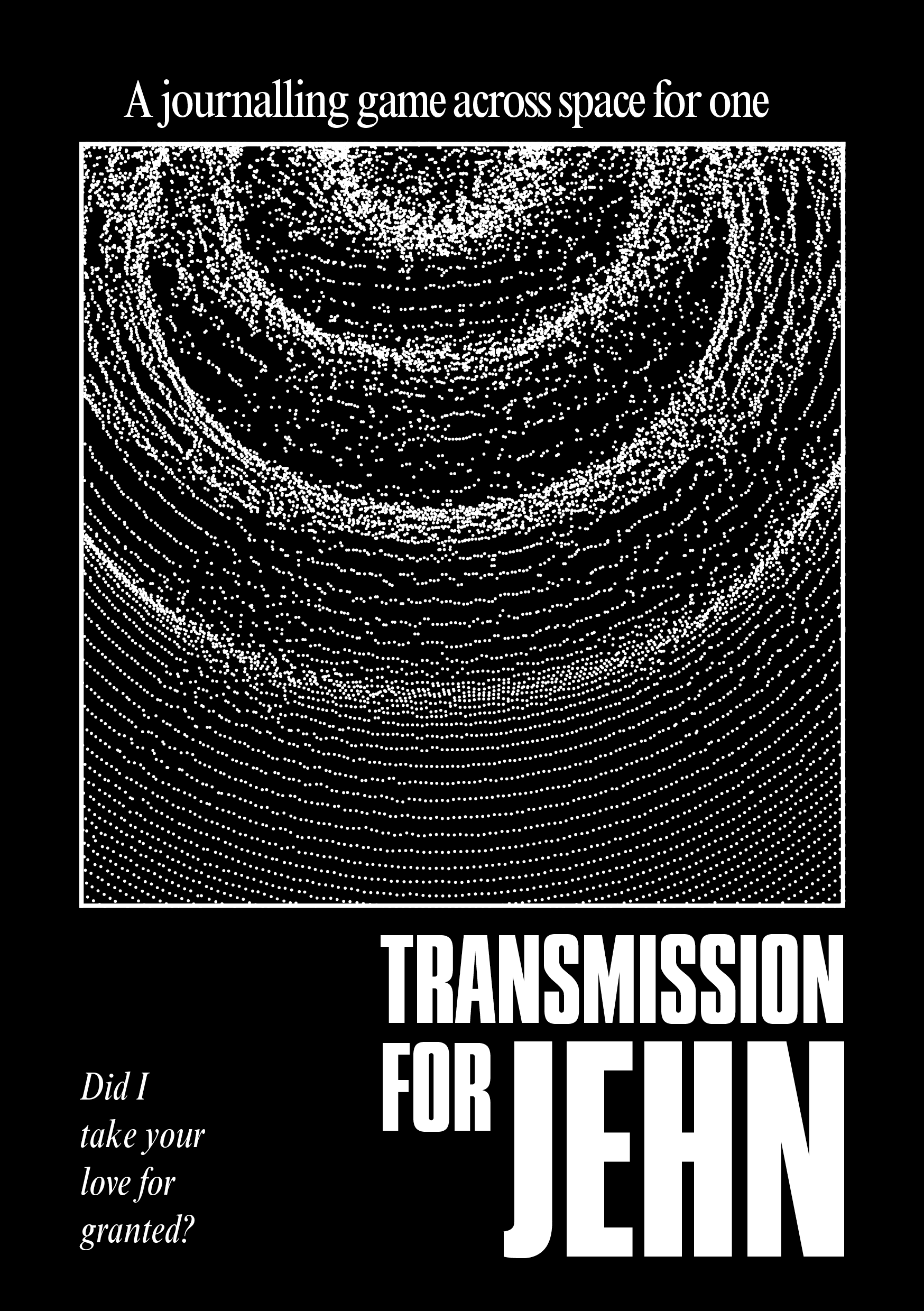
trying to write a solo journalling game and the writing bit isn't going so well so I'm making the awful error of starting layout first. also committing the cardinal sin of making everything white on black. print shop is gonna hate me pic.twitter.com/gqgx1e6ngs
— Eryk (@peregrine_coast) January 12, 2022
I shared the cover before I had anything else down - it’s pretty much the only thing that remained unchanged from start to finish. It got some cracking responses which really helped get over that initial motivation bump.
Choosing white-on-black was a huge constraint I wanted to test myself with. I’ve been learning layout and graphic design mostly through doing (and I want to give a huge thanks to everyone who paid for anything I’ve put out so far - you’ve basically been paying for me to learn in public), and Filmmakers Without Cameras and Demesne of Conflagration were both really maximalist, varied pieces of work. This was supposed to be the opposite: two colours, 16 pages, and a chance for me to try more graphic design.
The white-on-black feels like an obvious choice for a piece set in space: the dimensions of the page seem to fade away and the white text stands in stark contrast to its surroundings. It’s pretty neat!
 _first-spread.png
_first-spread.png
I got this idea of “elegance” into my head fairly early on - I wanted sharp lines, stark contrasts, and balance. Looking at these spreads felt amazing; I wanted to put one prompt on each page to give the prompts all that breathing room, to make them look lost in space. Alas, this thing had to get printed and bound somehow.
This was also where Sam and Josh, the writers, came in. My prompts up until this point were very simplistic: “How did you meet them?” and “What was your last argument about?”. They came in and blew my word limit wide open. There’s a running theme in my collaboration with Sam & Josh and Charlie. I went for ultra-minimalism, and they… didn’t. 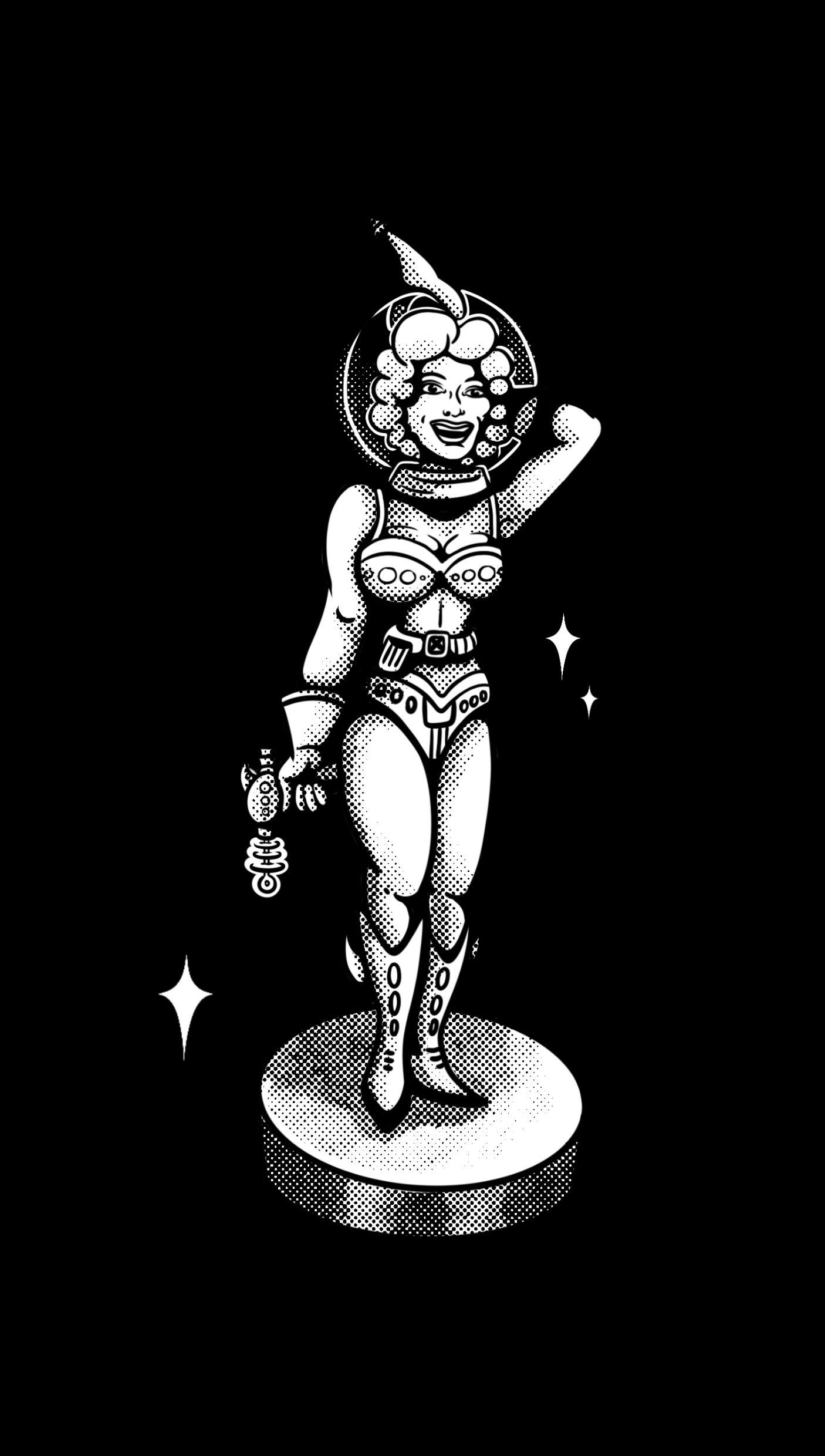
It made for a nice balance. Transmission For Jehn is a magical piece of work; the narrator talks about going to space as if it’s no big deal. He has Sun Ra on speed dial, and he makes short work of Europa, Io, Ganymede and Callisto. Contrasting my layout inspired by the sharp lines and contrasts of hard sci-fi with Sam & Josh’s descriptive, flowing prose and Charlie’s psychedelic lines ended up in a great marriage of the real and fantastical. At least I think so - I hope it comes through!
Charlie’s art piece above is lovely, but it doesn’t actually appear as a spot anywhere in Transmission (though it is in there - bonus points to anyone who can find it!). We agreed that it was a bit too booby for the vibe we wanted and had to go back to the drawing board to find a style that was more reflective of Transmission thematically.
There’s also a reference in Transmission to a film I have a lot of love for - I was worried it was a bit too on-the-nose but so far nobody’s pointed it out. The first person to point it out will get a free, limited edition Transmission For Them patch 👀 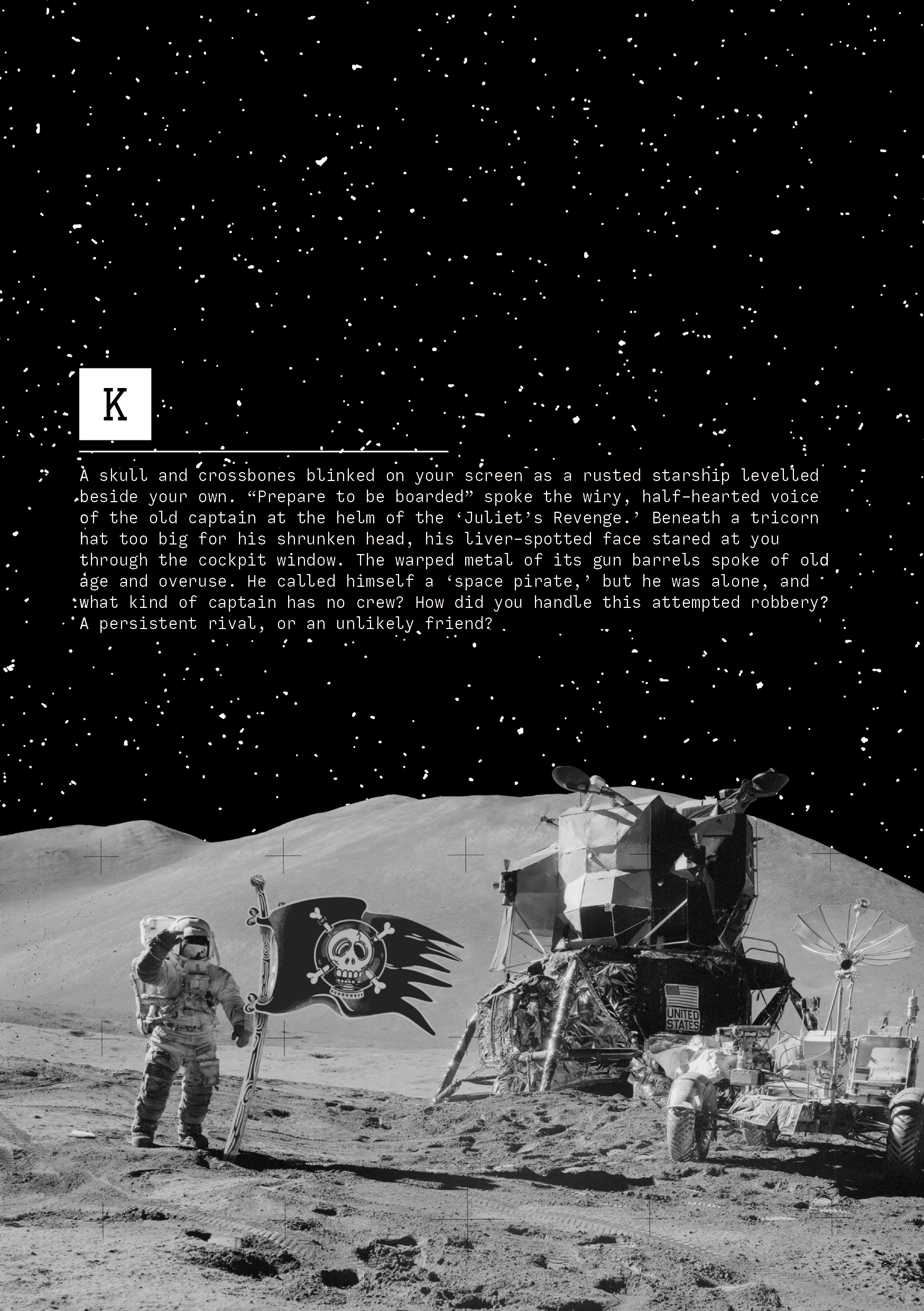
Combining the real-world Moon landing photography with Charlie’s art is reflected in our prompts, too. At any moment you could draw a card asking you to reflect on very human moments with your partner, while another card could ask you to reflect on the pod of space whales swimming alongside your spaceship. Magical realism is another soft spot of mine.
I still threw in some ultra-minimalist bits, though! I approached most of the chapter headers by asking myself how I could represent the key ideas of each chapter as minimally as I could. No ideas come from a vacuum, though, and I spent an unholy amount of time scrolling down Pinterest. My main feed is still mostly made up of white-on-black art. 
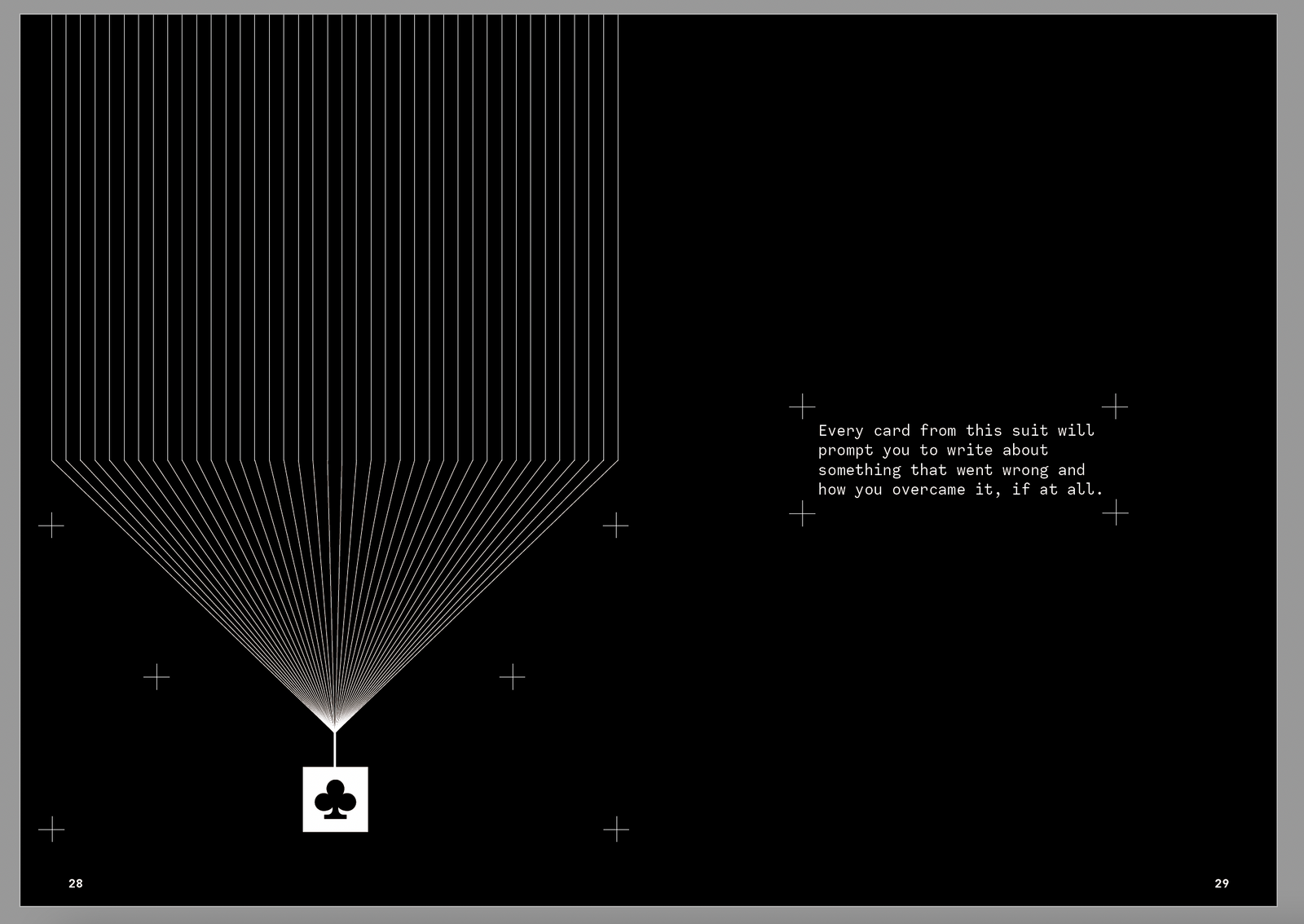 —
—
Here’s the nitty gritty: by far the hardest and most tedious bit of the whole process was fitting prompts into a layout which conveyed space but also remained economical to print. I set down some ground rules to start with:
- Each prompt could not break on to another page.
- Each prompt had to be easily referenced.
- Each page had to be balanced.
 By setting the baseline grid to match my desired leading, I could maintain an even leading between pages. I used that to figure out my total line budget per page: 50. From there, I knew that each prompt would take up at least 8 lines - 2 lines above and under to act as padding, and the remaining 4 lines for the card number and divider. This was hugely helpful in balancing each page - there were times where I’d be shifting two or three prompts around to free up one or two lines on a page.
By setting the baseline grid to match my desired leading, I could maintain an even leading between pages. I used that to figure out my total line budget per page: 50. From there, I knew that each prompt would take up at least 8 lines - 2 lines above and under to act as padding, and the remaining 4 lines for the card number and divider. This was hugely helpful in balancing each page - there were times where I’d be shifting two or three prompts around to free up one or two lines on a page.
I ended up changing header fonts fairly late into design - the opening spread gave me some trouble. When I initially wrote it, I really leaned heavily into the Transmission For Jehn inspiration. We steered away from that, luckily, and that proved to be a much more interesting direction. Below is the same spread as it looked at the start and end of the design process. 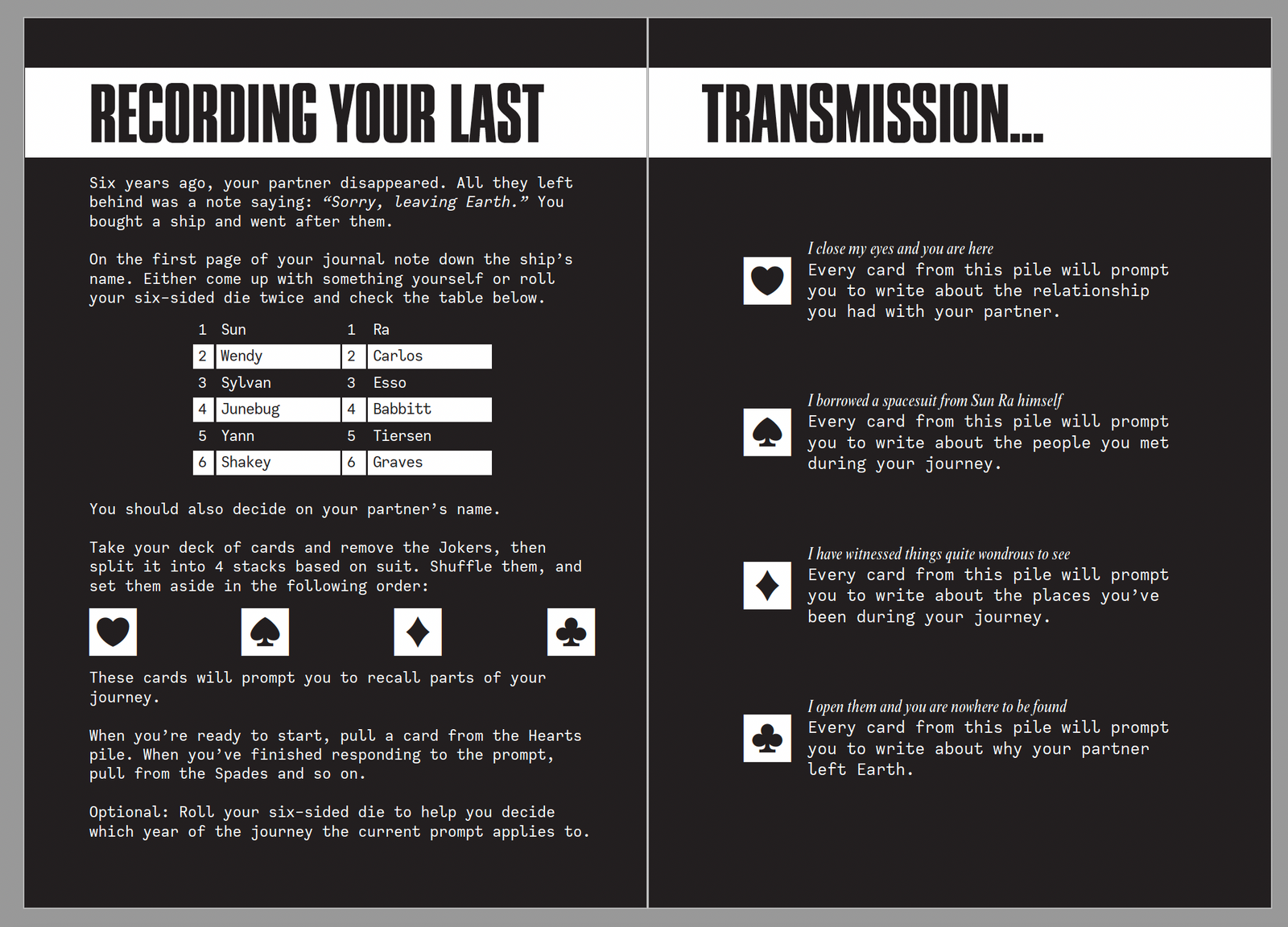
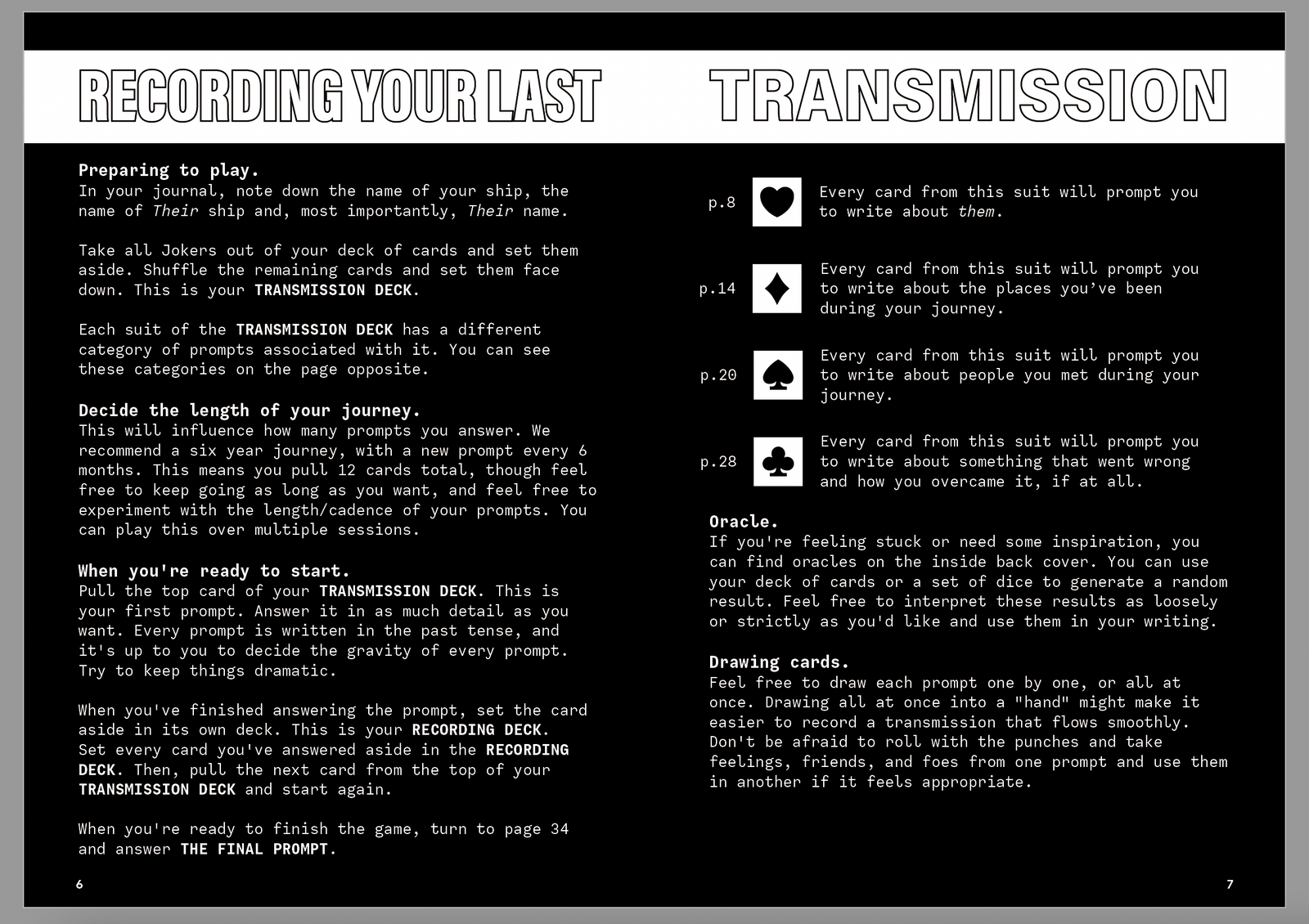
Ignore the colour difference between the two - that was an export mistake I made at the time.
The first header font was the font I’d used on the cover. I tried to make it work for the sake of consistency, but it’s fair to say that it didn’t work at all. The new font was a bit of a cheat; it’s variable so I could tweak its width to fit the space.
I hope these half-formed thoughts made sense and are of some use ✌
Failures of the world, unite!
Metal Gear Solid’s (1998) GAME OVER screen has become a gaming icon; “It’s video game’s iconic scream.” wrote Zack Kotzer for Vice. The devastated exclamations of Solid Snake’s team echoing against a black screen overlaid with neon, futuristic lettering is proof of one thing: the player had failed, and Snake had died. Snake had died because the player failed. Considering failure and success as a life-or-death situation seems reductive, an equivocation entirely unrelatable to most people who pick up a game controller. But adhering to these black & white, good & bad definitions of failure is commonplace in videogames. So, I ask: what happens when we begin to look at failure as a state of different degrees? When we question the systems which enable success and failure? Most importantly, what happens when we recontextualise failure as appealing? Jack Halberstam, Professor of Gender Studies and English at Columbia University, writes that “There’s another kind of pleasure in that … You rewrite the game, and in the process you accept what we call failure.” It’s Halberstam’s work that I want to talk about the most here, specifically, The Queer Art of Failure.
It’s only fitting for an essay about failure to begin with a disclaimer: I am cis-gendered, white, and heterosexual. It’s important I mention this now because I’ll be looking at Disco Elysium through a queer lens shaped by my own heteronormative experiences; my experiences are inseparable from the way I understand the game. In her book Queer Phenomenology, Sarah Ahmed speaks of “orientation” as beyond the commonly understood sexual orientation: “Orientations shape not only how we inhabit space, but how we apprehend this world of shared inhabitance, as well as ‘who’ or ‘what’ we direct our energy and attention towards.” I am a Polish immigrant to England; my parents and extended family are manual laborers from a post-Communist era. My political orientation sits firmly, firmly left. After an extended conversation with my partner, we both settled on the idea that we identify as male and female, respectively, because that’s what we’re used to. Being referred to as a man doesn’t feel wrong, and so the label stuck for the past 24 years. I am heterosexual so far — my lived experience has been privileged by the lack of fear that feels so common to queer lived experience — but I cannot say this with full certainty. In Queer Game Studies, Adrienne Shaw and Bonnie Ruberg write that “Queerness, as its heart, can be defined as the desire to live life otherwise, by questioning and living outside of normative boundaries.” I feel that. Having lived my entire life happily benefitting from passing as a heterosexual man, it approaches stolen valour to say that I identify with queerness. The queer experience is not, of course, defined by suffering.
Halberstam argues that heteronormative societies (ones where heterosexuality is dominant and the assumed “norm”) equate success with getting better, getting richer, growing a family, buying a house and a car and so on. Queer and “counterhegemonic” modes of thought equate failure with a refusal to conform to those: not seeking riches, not growing a family, critique, and negativity. If you’re a queer person, you have two options: to apologise, change your ways, and say that yes, I will get married, have kids, play the game your way and hope that you see me as a success on your terms. The other, obviously, is to fuck it all off. Halberstam is talking about real life, a philosophy to live your life by. But I want to apply this to video games, too, and there is no better example of a game which supports this than Disco Elysium. By willingly failing, we reject the terms of success established by another and instead we establish our own boundaries, facing a moment of self-actualization: defining our own terms for success. The terms of success in videogames with point-scoring systems or competitive systems are clear. In roleplaying games, these terms are less clear. Kathryn Boyd Stockton refers to an “accumulation of anti-capital” (Shaw and Ruberg, 2017, p.208), with capital being this Marxist understanding of wealth and the power to generate wealth. It is this accumulation that builds up value over time, and it is these failings that feel awful in the moment but yield greater benefits over time. Failing a skill check feels terrible in the moment, but it defines Harry Du Bois. With every failed skill check, we get some glimpse of a man broken by his demons, by his ideology, and by the world around him.
So, what is wrong with success, getting better, having a family, and being an individual? At face value: not much. But Óliver Pérez-Latorre and Mercè Oliva write that “free choice and individualism are at the core of neoliberal governmentality”. They go on to write that “Neoliberalism is based on placing the responsibility on individuals, who must look after themselves, while it also advocates the dismantling of public policies. In other words, in neoliberal societies, individuals are expected to govern themselves according to certain objectives.”. The genre of roleplaying games overlays with neoliberal politics very neatly: both are concerned with self-governance (Bioshock), self-improvement (Path of Exile), and are usually highly individualistic (The Elder Scrolls V: Skyrim). The win conditions of these games almost always revolve around a Hero, a singular actor who, through sheer effort and self-determination, faces some challenge and brings some change (mostly good) to the world. These changes aren’t systemic; there’s no Johan Galtung-styled Peace Studies theory to resolving the conflict between Skyrim’s Empire and the Stormcloaks, no regulations, sanctions, or reform inherent in systemic change. Just effort, might, and sheer determination. Defining failure through the lens of neoliberalism leads us to a similar outcome as Halberstam; collectivism becomes a form of failure. You’re not pulling yourself up by your own bootstraps, but depending on the systems you exist in and the people around you to help. This neoliberal approach to failure places the player in opposition to the game systems; the player is expected to persevere, grow, improve, and triumph over the game’s challenges. When we look at Disco Elysium, we know that this is not a game requiring dexterity or other forms of player skill; it’s slow and prose heavy. Brendan Keogh, lecturer of videogame studies and culture at Queensland Digital Media Centre, writes: “… videogames produced beyond the confines of the high-budget blockbuster industry are instead phenomenological— explicitly that of situated navigation rather than godlike configuration, a corporeal engagement of the senses rather than an intellectual engagementof systems— and they require an integrated and cooperative relationship between the human and the computer.”
Phenomenology is a philosophical school of thought, widely agreed to have been founded in the late 20th century by Edmund Husserl. A succinct definition can be found in the Stanford Encyclopaedia of Philosophy from David Smith: “phenomenology is the study of “phenomena”: appearances of things, or things as they appear in our experience, or the ways we experience things, thus the meanings things have in our experience. Phenomenology studies conscious experience as experienced from the subjective or first person point of view.” (Smith, 2018)
This is a key concept for considering videogames, especially roleplaying games, where the player is tasked with inserting themselves, or a character of their making, into the game’s world. Roleplaying games, above all, are concerned with the idea of “immersion” or “flow”, with the two terms often used interchangeably. And what Keogh writes is largely true: it only takes a quick look at the receptions to games like Gone Home, Dear Esther to see that those smaller games often concern themselves with the feeling and affects of inhabiting a space. It takes another quick look to see that anything dubbed a “walking simulator” is given a sideways glance because it doesn’t meet some arbitrary standard of capital or development quality. Taken in the context of Disco Elysium especially, the game presents the player with a breakdown of every aspect of Harry’s personality.These 24 aspects break down the barrier between Harry’s phenomenological experience and the player’s. Some of these aspects, like “Endurance”, “Pain Threshold”, “Encyclopaedia”, “Rhetoric”, and “Empathy” are self-explanatory. Others, like “Inland Empire” and “Electro-chemistry” are more abstract and instead make a statement about the kind of person Harry is/was. “Inland Empire” is described in-game as: “Hunches and gut feelings. Dreams in waking life.” (ZA/UM, 2019)
To bring this back to Keogh’s initial point, I’d like to make a connection to Donna Haraway’s idea of the “cyborg” as “creatures simultaneously animal and machine, who populate worlds ambiguously natural and crafted.” (Haraway and Wolfe, 2016, p.6) If the neoliberal approach is to dominate the system and the game then, conversely, I want to apply the idea of the cyborg to a gamer who integrates with the game systems.
This “cyborg-gamer” Keogh outlines is a more apt lens for me to approach Disco Elysium with. Disco makes clear the factors which affect the player’s rolls. If the player, for example, maintains an amicable relationship with Kim Kitsuragi, the interface indicating a dice roll during a pivotal narrative beat will display the following disclaimer: “+1 — Kim trusts you”. If the player develops a friendship with Lt. Kitsuragi, the game will also show: “+1 — Kim really trusts you”. While the game relies on dice and chance to randomise outcomes, it also offers the player assistance. To turn down the game’s assistance and instead “savescum” is “to abolish chance by holding it in the grip of causality and finality, to count on the repetition of throws rather than affirming chance, to anticipate a result instead of affirming necessity.” writes French philosopher Gilles Delezue. So, the cyborg-player is one who denies the hegemonic dominance required of neoliberal approaches to failure, and one who aims to integrate with the game’s systems. So, to integrate with the game’s systems is one thing but lacks purpose independently. Why should the player integrate with the game’s system and stop trying to dominate it?
Well… this takes us back to Halberstam’s writing: we should embrace this queer art of failure when playing roleplaying games. Indeed, outside of them too, but I don’t think I can convince you to live your life differently with this word limit. There’s a character in Disco Elysium who seems to embody this. Someone who rejected success.
Deep within the Doomed Commercial Area, past its offices and maintenance tunnels, by a window overlooking Revachol and next to a now-defunct chimney stack sits a Novelty Dicemaker. She doesn’t have a name; the Novelty Dicemaker is one of the few characters defined by their labour. She runs, right now, the only successful business operating out of the Doomed Commercial Area. She laughs the “curse” off as mere superstition but acknowledges that the chimney stack is technically outside of the building. The Novelty Dicemaker is the only one who seems to have staved off labour alienation, using Marx’s definition of a worker who has been separated from the product of their labour, and instead works independently, creating a product which she herself sells to a local community she is part of. The Dicemaker is, by capitalist definitions, a failure. She lives by herself, in a property which doesn’t belong to her, and she does not accumulate wealth. Nonetheless, this highlights that the neoliberal use of “self-improvement” isn’t an inherent negative and shouldn’t be looked at as such. Growing one’s skills isn’t a malicious scheme to extract profit and alienate workers from their labour. At least… not always. The difference here is between self-actualisation and labour alienation; the Dicemaker has reached a point of equilibrium. Her skills provide for her lifestyle, and nothing more.
By applying queer readings to games, we can form other, non-hegemonic definitions of play itself. Playing not to finish the game, but to spend time in its space, to score the lowest score, or to play in ways unsupported by the game’s systems are all means of queer play which would be treated as “failure” by the society we live in. But it’s a start; exploring what it means to play, fail, and succeed through videogames can be a safe start to exploring our own worlds and lives, and what our society values.
Twinery
Introduction
Narratives, game design, and interactive fiction are all topics I’ve been interested since picking up a controller over 10 years ago. Our task here was a perfect fit; to create a short narrative using Twine, “an open-source tool for telling interactive, nonlinear stories” (Twine, 2009). Bringing the idea of “surface effect” (Anable, 2018), that is, a user’s body having an effect over code with touch, we consider how platforms and data affect the users and how creating these pieces of digital art requires a deeper understanding of the code that makes it all possible. Throughout our task we encountered language barriers, cultural barriers, and skill barriers, all of which guided our understanding in different ways. When reflecting on these barriers, it has encouraged me to explore alternative platforms for showcasing creativity in storytelling; it has helped me to think proactively about my own role in facilitating the overcoming of them in future collaborative work.
Analysis
Aubrey Anable asks “What kind of encounter is it when we touch the screen of a digital device?” (Anable, 2018). Her answer, then, is that it is “an intimate encounter—meaning that, like all touching, it simultaneously designates self and other and the confusion between these designations.” (Anable, 2018). Having started a university course amidst a pandemic, this answer seems almost entirely relatable. My classmates are behind screens, as are my lecturers, as are most of the books I now have to read digitally. Everything about university has been an other that has no bearing on my day-to-day outside of neatly-allocated hour-long slots once a week. With that comes the issue of language barriers too. The neat affordances that technology provides: taking a course alongside people from all over the world, from different cultures, time zones, and languages, brings into light a new issue, one that seems unsolved right now. My course mates speak a different language. Espen J. Aarseth’s Cybertext: perspectives on ergodic literature (Aarseth, 1997) is based on an assumption that we all speak the same language, an assumption one would have no reason to challenge… usually. These are, of course, unprecedented times, and my peers do speak a different language. The language barrier became an underlying theme in much of our work; it’s impossible to talk about the task, its insights, and its relationship to the assigned reading without mentioning the language barrier. To directly quote merritt k’s The Empathy Machine, “isn’t empathy about simultaneously holding difference and sameness without subsuming either?” (k, 2013)
Twine promises a simple enough means of creating multicursal, ergodic narratives. Its story formats are CSS-adjacent; knowing one can massively help with the other. Of course, to many of us CSS was a fresh skill, and we weren’t well versed in CSS or Twine. We found a compounded challenge: the technical language of Twine and CSS, the emotive nature of “affect” in Anable’s writing, and reconciling those through our lingua franca. In a similar vein, programming languages are categorised as “high level” and “low level” based on the abstraction between hardware and user readability — overcoming the language barrier beyond programming was even higher; a “meta level”. Of course, CSS and Twine itself are both reliant on a presupposed knowledge of English. We struggled immensely to overcome this, and I’m not sure if we ever did. As a result, our narrative was simple; a linear sjuzet without any branches and only one choice.
Creating “affect” also relied on a certain level of cultural and geographical knowledge — when crafting our story based on Sarah’s fictionalized weekend, we added a tongue-in-cheek choice that allowed the player to choose where Sarah went on holiday. Our jokey staycation option was “Cornwall”. Without the context, the experience of clicking through our Twine game was exactly the thing merritt k was wary of in her game The Empathy Machine; we were reducing the complex lived experience of people immersed in our local culture enough to assume that a simple on-screen choice would cause a universal response in all players. In hindsight, it was a privileged thing to assume and as a result our peers from different backgrounds were confused, asking “what is Cornwall?”. We were, in effect, using a technology none of us were familiar with, telling a story in a language that was second to our native languages (Sarah being the only native speaker), and using cultural shorthand for the purposes of humor. The impact of comparing the Maldives to Cornwall was likewise a gamble; a punchline made effective only by my lived experiences and not necessarily those of my peers. It’s an uncomfortable mirror of the “power” disparity — why were our Euro-centric narratives taking precedence over those of my peers, when those narratives are in a numerical minority (Western cultural homogeneity aside)? In the words of Anable: “A computer program may not fully capture the complexity of what gender feels like, but that does not mean that it cannot create a circuit of feeling across screens, language, code, and bodies.” (Anable, 2018) — in this case we aren’t talking about the lived experience of gender specifically, but it is lived experience, nonetheless. We may not have been able to capture the specificities of visiting Cornwall, but we used code to add visuals and sounds that aimed to replicate the experience.
Another idea of Anable’s that stuck with me was that of “feeling code” (Anable, 2018) — the idea that we could be intimate with computing systems in a way that other digital medias don’t allow us to be. In this case, we added a simple line of text referencing the Royal Sceptre. When clicking the term “Royal Sceptre”, the text was replaced with “(yup, had to google that one too)”. It was, like earlier examples, a joke trying to get a reaction out of our players; a cheeky nod towards the outdated, sentimental theatrics of the British Monarchy. This time, it landed. It was “the game’s code touching us back when… our desire for a certain outcome [was] trumped by the game’s programming, its desire to move us.” (Anable, 2018) The player’s expectation might have been that of clarification: a Royal Sceptre isn’t something that comes up in day-to-day conversation much. There might be an expectation, inherited from literary media, that the words on the page (and, by extension, the author) are knowledgeable and trustworthy, and their expectation might have been that the nature or history of the Royal Sceptre would have been revealed to them. Instead, the players had their expectations subverted: the game produced a human response, one of uncertainty, and one that acknowledged its place in time. It referenced a platform, a brand, so ubiquitous it’s been assimilated into our languages as a verb. The game’s desire to move the players to laughter trumped whatever interest they had to move the story forward or satisfy their curiosity. Something I hadn’t considered during the task was how much we relied on Google and other search platforms. By making the context of the Sceptre a punchline, I assumed that the players would assume it was a throwaway line, the Sceptre itself irrelevant to the game. Anyone who genuinely wanted to find out more would have to resort to Google.
The idea that a game has a “desire to move us” (Dixon, 2018) is interesting to me, and brings back a rather unpleasant experience I had playing The Last of Us Part 2 (Naughty Dog, 2020). In a similar vein, the game’s events are deliberately built on the player’s desire for a certain outcome being consistently trumped by the game’s programming; by the game’s desire to move us. In an interview with GamesRadar, co-writer Halley Gross says “Ultimately, this is a story about the cycle of violence, right?” (Weber, 2019). The game’s protagonist-turned-antagonist is a young woman named Ellie, driven by revenge. At the game’s halfway point, when things have seemingly calmed down and Ellie settles down with her partner having adopted the baby of a now-deceased friend, Ellie leaves in the night. Unable to reconcile her need for closure, she decides to leave her idyllic farm life behind, and ventures off to kill the people who wronged her. It’s a clear example of the game touching the player — I found this frustrating and unrelatable. People hold grudges, but my grudges don’t spiral into murderous sprees. I wonder, then, where the tipping point lies for the game’s desire to move us becoming farcical, when the player gives up trying to empathise with the game’s characters and themes, when the game is so clearly set on evangelising an unrelatable “cycle of violence” to us. Maybe our text replacement joke was effective purely because it was throwaway — it wasn’t an experience that would last another 10 hours, it wasn’t an experience that had lasted 25 previous hours split across two games, and two very expensive games consoles. This frustration is a valid affect in itself — stories with unlikeable, misguided characters are allowed to exist. The affect is amplified by the game feel, “the feelings of connection between bodies and computational processes through the touchscreen interface.” (Anable, 2018). The Last of Us 2 doesn’t rely on a touchscreen, but the controller is a unique method of input to games. Twine only relies on simple mouse input, meaning it can be used on touchscreens, touchpads, or with mice. Video game controllers require an abstraction of the character’s abilities that are then tied to an abstracted button on the controller. The only similarity between the character’s action and the interface the player is using is a trigger; a button shaped and designed to replicate the feeling of using a firearm. Each button press throws Ellie into another desperate strike, the game waiting, taunting, and pushing the player to fulfil Ellie’s prewritten destiny and commit horrific acts of violence. The player only has two choices: to take part and be complicit, or to not play at all. There seems to be a marked difference between watching Breaking Bad’s (2008) Walter White lie to his family and make drugs for cartels, and playing Ellie’s descent into villainhood. Having some affect is certainly better than none at all, and being complicit with Ellie’s actions can leave the player feeling guilty. It seems to be a deliberate decision: the cycle of violence waits to be broken, and the game actively calls the player out for taking part. Though a lengthy and, admittedly, extreme example, I wonder how many times we could use techniques like the text replacement in our Twine game before the player feels that the game isn’t respecting their time. It is a worthy lesson to be mindful of in future endeavours; balancing this desire to move the player whilst not descending into emotive extremes for the sake of inflammation.
It is interesting to consider the increasing requirements placed on independent creatives to move with the times. Where subcultures and countercultures would once communicate largely through zines, focus shifted towards digital story games made in Twine, to now the scene settling on Bitsy. A web-app at its core, Bitsy allows creators to make small, 8x8 pixel-art worlds, complete with tools for players to interact with characters, explore, and pick up items. Both of these formats balance technical skill with creativity: they have to be accessible enough for underrepresented voices from a diverse range of backgrounds to use, but also technical enough to allow for mastery whilst hiding from the watchful eyes of the power elite. In the words of Adam Dixon for Rock Paper Shotgun, “While it’s easy to learn for beginners, there’s still lots of space for experienced creators to experiment with.”(Dixon, 2018). Where Twine requires a knowledge of CSS and its proprietary story formats to truly break out of the box and experiment with multicursal, emergent narratives, Bitsy now adds a layer of art and animation to the mix. An independent creator is faced with the challenge of learning the basics of animation, CSS (and even JavaScript in some instances), writing, art direction, and sound design. To be an independent creator is to be multi-skilled, and a sad reflection of our current economy: entry level jobs requiring experience using the full Adobe Suite, having years of experience in fields that have only recently sprang up, and an arms race to create the most versatile creatives possible. Long gone is the age of the writer: what use are they if they can’t lay out, design, edit, and code their own game? Bitsy creator Adam Le Doux said of Bitsy: “People have drawn parallels between Bitsy and Twine, but I’m not sure if they’re thinking about the tool as much as the shape of the scene forming round it.” (Dixon, 2018) and I’m inclined to agree — both communities are welcoming, full of people making small, unfinished, intensely personal projects and helping fellow creators hack the tools to their needs.
The brief time we spent working with Twine brought to light its shortcomings: while a powerful tool, we spent most of our time reconciling the differences between CSS and its story format. It was a finnicky process of finding out how to do a specific thing (like importing fonts from Google) using CSS, to translating that CSS to be Twine-friendly. It took us too long to figure out that the CSS element body; was actually tw-body; in Twine. Trying to explain this to each other while one person was sharing their screen (“no, no, see the ‘Edit Stylesheet’ button? put that on the second line from the top…”) with the language barrier likewise not offering any respite was a difficult task. We had other ideas, too, that were simply not possible within the time we had, especially when you consider the time we threw aside trying to change a simple font. For the popularity Twine has amongst independent creators and game designers, it entirely lacks a “What-you-see-is-what-you-get” editor – changing fonts in a word processor is one of the first things we learn to do on a computer, and it becomes frivolous, requiring no effort or time. Here, we had to engage with code instead, using a different syntax, following a new kind of logic that we hadn’t had to consider before. This stretched beyond changing fonts, too. Changing the color of the background, adding pictures, ambient sound, all required engaging with the code that Twine runs on. There was no simple drag and-drop functionality: adding pictures or sounds required a lengthy process of downloading and reuploading the files we wanted to a public repository, then linking to them using HTML. We would have loved to make the Royal Scepter something our player character could hold, or an item they needed to acquire before progressing. Bitsy is made with those considerations — its sprite editor would have allowed us to draw an 8x8 character complete with two whole frames of animation. It would have allowed us to make a space for our character to move around in, and possibly find and wield the Scepter. All this, without having to delve into the fiddly bits of code. Neither of these are suited for collaborative work, however, as each project is stored locally and has to be assembled by one person. The technology that allows us to communicate intercontinentally also robs us of the immediate “presence” — I can see my peer’s screen, but I can’t point to the image on the screen I’m referring to.
Conclusion
Overall, this task was difficult to draw conclusions from. We found communication a nigh insurmountable challenge, one that didn’t allow us to fully interrogate Anable’s ideas of “surface affect” or “touching code”, nor explore Twine’s potential to create multicursal, branching narratives. Nonetheless, the brief game we’d made gave way to analysis regarding humour as subversion; one could say that subversive humor is exclusionary by design. For the humor to land, you have to know what is being subverted. We’d explored the strengths of Twine and found it to be a neat “wrapper” for technical skills like CSS and HTML that none of us really had; though I’d be keen to persist with it and engage with the community that sprung up around it. The most interesting part of this reflection was engaging with the idea that games have a desire to move us, expressed through their code — when is the breaking point for these narratives to alienate the player rather than engage them? Applying this idea to public spaces which use algorithms to curate visitors’ experiences is also incredibly interesting: when a visitor knows their experience is being curated, do they become disillusioned with what’s being presented to them? For all intents and purposes, Twine still facilitated our collaborative project and, despite wide ranging shortfalls, allowed us to communicate a simple yet enjoyable story to a specific audience of player. Additionally, it gave us the space to learn basic CSS skills that we can transplant into future work. In that sense — it was a success. Looking beyond this, however, the accessibility problems identified and lack of creative depth in Twine has sparked an important conversation for me to grow from in future work; both collaborative and solo.
Bibliography
Aarseth, E.J. 1997. Cybertext: Perspectives on Ergodic Literature. Johns Hopkins University Press. Anable, A. 2018. Playing with feelings : video games and affect. Minneapolis: University of Minnesota Press.
Dixon, A. 2018. How small game makers found their community with Bitsy. [Online]. [Accessed 17/12/2020]. Available from: https://www.rockpapershotgun.com/2018/02/23/how-small-game-makers found-their-community-with-bitsy/
k, m. 2013. The Empathy Machine. [Twine game]. [Accessed 11/12/20]. Available from: https://web.archive.org/web/20170310220521if_/https://a-dire-fawn.itch.io/empathy-machine Naughty Dog. 2020. The Last of Us: Part II. PS4 [Game]. Santa Monica. [Video game]. Twine. 2009. [Online]. Available from: twinery.org
Weber, R. 2019. The Last of Us 2 is “a story about the cycle of violence”, says co-writer Halley Gross. GamesRadar. [Online]. [Accessed 17/12/2020]. Available from: https://www.gamesradar.com/uk/the last-of-us-2-interview-halley-gross-2019/